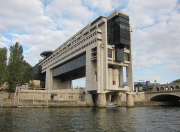
A researcher claimed Tuesday to have discovered the exact spot where Vincent Van Gogh painted his last canvas before his mysterious death from a gunshot wound.
The tortured Dutch artist had been working on "Tree Roots", a jumble of brightly-coloured tree trunks, roots and stumps near Auvers-sur-Oise, north of Paris, on a hot July day in 1890 when he staggered back wounded to the village inn.
Wouter van der Veen, of the Van Gogh Institute, which looks after the artist's room at the Auberge Ravoux where he spent his final 70 days, said most of the tangle of roots is still there, a stone's throw from the inn.
Experts at the Van Gogh Museum in Amsterdam have backed the finding, saying it was "an interpretation, but it looks like indeed it is true."
The museum's director Emilie Gordenker and the great grandson of Van Gogh's younger brother Theo travelled to the village Tuesday to unveil a plaque at the spot.
Van der Veen told AFP that he made the breakthrough from a postcard of the village from the turn of the 20th century, which shows an embankment with the trees on the main road through the hamlet, 30 kilometres (18 miles) north of Paris.
He was going through some documents during the coronavirus lockdown when "my eye was caught by a detail from the postcard".
'Shot by accident'
He compared it with the painting and found "that the trunks and roots corresponded.
"Discovering the place where Van Gogh painted his last and most mysterious work is a waking dream which I am still trying to comprehend," the researcher added.
Teio Meedendorp, of the Van Gogh Museum, told AFP that Van Gogh would have often passed the spot "going out to the fields behind the chateau of Auvers where he painted in the last week of his life."
Because of the way the light falls in the painting, Van der Veen said Van Gogh was probably still working on it late in the afternoon, "about 5:00 pm or 6:00 pm".
This, he argued, could help disprove the controversial theory that Van Gogh had not killed himself but had got drunk and fought with two local boys who shot him by accident.
The theory was first floated in a biography of the painter by the Pulitzer Prize-winning authors Steven Naifeh and Gregory White Smith nine years ago, and featured in the 2018 movie "At Eternity's Gate" starring Willem Dafoe.
Its director, the American painter Julian Schnabel, told AFP when the film was released that Van Gogh was probably murdered.
He insisted that a man who had painted 75 canvases in almost as many days at Auvers-sur-Oise was unlikely to be suicidal.
Schnabel also claimed that "the painting material he had that day was never found.
"It is strange to bury your shit if you are committing suicide," he added.
'Lousy' murder theories
But Van der Veen dismissed "these lousy theories", insisting that for him the painting was Van Gogh's final "testament, a farewell letter... Suicide had been an option for him for a year".
Van Gogh had been in an asylum near Arles and released just three months earlier.
"The thicket of roots was a symbol of the struggles of life. We cut down the tree and from their stumps new shoots appear.
"It makes sense, the theme of life and death, and eliminates all these lousy theories which do little for his memory," Van der Veen said.
The revolver with which Van Gogh is believed to have shot himself in the chest sold for 162,500 euros ($182,000) at a Paris auction last year.
Discovered in a field near the village, it was billed as "the most famous weapon in the history of art".
The rusty 7mm Lefaucheux had already been exhibited at the Van Gogh Museum in Amsterdam.
While the Van Gogh Institute said the link with painter could not be proven conclusively, the bullet extracted from his stomach was the same calibre as the one used for the Lefaucheux revolver.
AFP








































